The Model 642–2 Airweight .38 Special revolver is a J-Frame. Smith & Wesson's J-Frame design originated around 1950 (though back in those days, the frames were steel). The 642 weighs 14.6 ounces and measures 6.3 inches overall, with a stainless barrel length of 1 7/8 inches. The cylinder and crane are also made from stainless steel, while the frame is aluminum alloy. This is a small, light revolver, which is the first clue why people still utilize these handguns.
The Airweight 642 is seriously concealable while still being a realistic defensive caliber. Yes, there are tinier revolvers, many of which are chambered for much smaller rounds that are not nearly as effective as the venerable .38 Special. I like to carry a defensive caliber of at least .38 Special in caliber. That's just my preference, but many others share my opinion. I don't want to launch into a caliber debate in this article; that's not my intent. Suffice to say, the larger calibers are generally more effective at stopping those who would harm us.
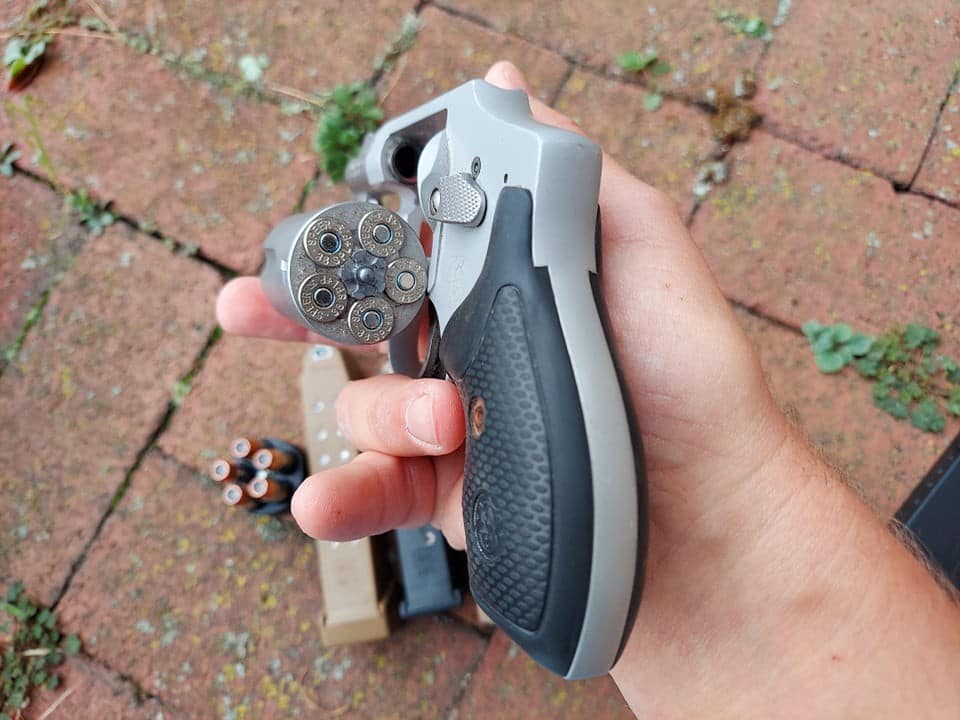
A Word About Handgun Bullets
They suck at stopping people! Contrary to what you see in the movies, people typically do not fall instantly and die when shot with a pistol. Can that happen? Sure! But it usually does not. It's not uncommon to see people running around animatedly after being shot. This is because pistol bullets travel at a much lower velocity than most rifle bullets.
Humans are stopped instantly by a hit to the Central Nervous System (brain or spine). However, a hit to any other body part is not a guaranteed stop. For example, even if the heart is hit, a person can still function for a short time.
The person's mindset in the situation is also a significant factor; someone engaged in combat will be fully adrenalized, which often means impervious to pain and able to function with substantial wounds. On the other hand, a person calmly walking down the street will be calmer and more susceptible to injuries. Many factors will affect the outcome of being shot, and I could go on for pages about it.
I've met and spoken with people who have been shot during violent encounters (and seen my fair share of violent/lethal encounters in person) during my career in the prison system. The amount of damage that a human body can absorb and continue to function is utterly mind-boggling! Many survivors report feeling no pain after being shot, with many not even realizing they were shot for some time. I was involved in an incident in which a mortally wounded individual continued fighting after he really should have been dead. His rage kept him fighting. Eventually, his birth certificate expired, but it took a few minutes. That was an important lesson to see.
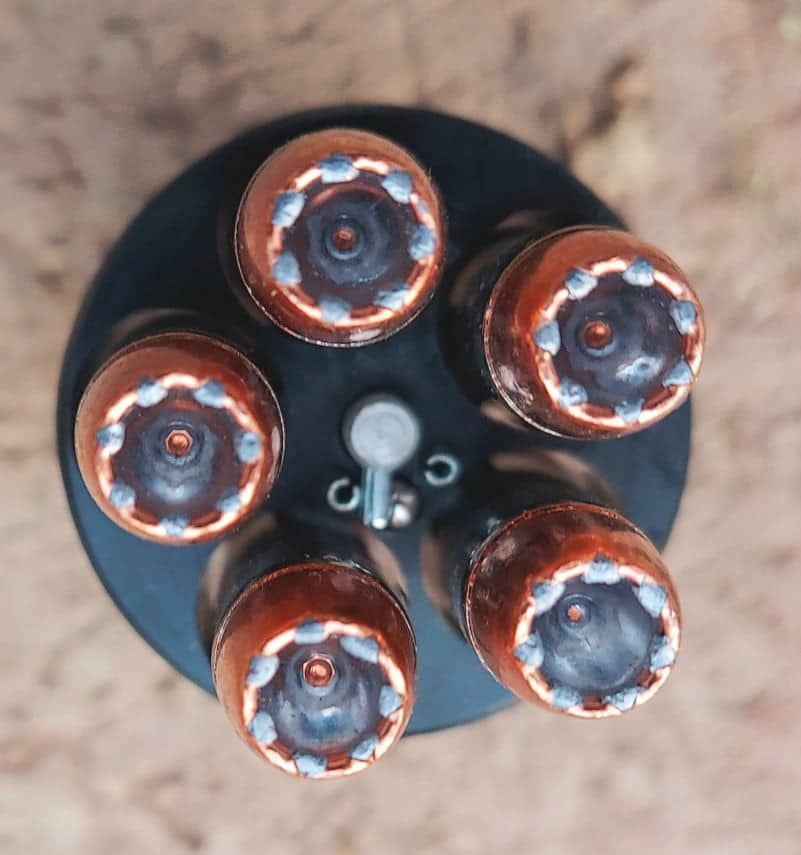
Back to the Smith and Wesson 642 Airweight
The appeal of the Airweight is how easily I can conceal it. I wanted to carry a defensive pistol in one of my former jobs because I had to venture into bad areas that former clients inhabited. Still, I didn't want coworkers or customers to see that I was carrying (I had the permission of my supervisor to be armed). My need wasn't necessarily to engage in a firefight with bad guys but rather to be able to defend myself and break contact quickly if I was attacked. The little S&W 642, tucked into an Inside the Waistband (IWB) holster, it filled the bill perfectly. No one ever knew I was carrying, and I had peace of mind because I could quickly access it. The IWB holster that I use is a Kydex model from DeSantis, which fits my needs to a tee. Not only does it function perfectly and do just what I need it to, but the price point is surprisingly reasonable.
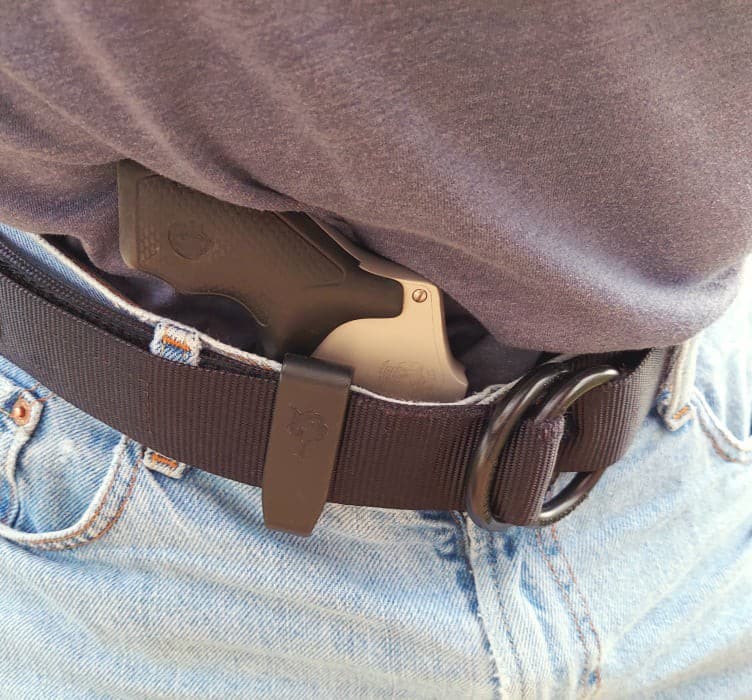
Another huge plus was that the little wheel gun is so small that it doesn't dig into my stomach when I bend over to do work. This adds tremendously to the comfort factor. It's a great handgun to carry when engaging in strenuous work.
Aside from an IWB holster, the Smith and Wesson 642 Airweight can be dropped into a pocket with little trouble. Sometimes it's the back pocket of my jeans, or maybe a coat pocket. It's super-convenient for quick trips outside or to the store. Typically, I prepare myself better with more serious hardware, but there are times when I'm in a hurry or don't feel like strapping on all kinds of gear. Another of my favorite uses for the Airweight 642 is when I'm outside doing yard work, and I want to be armed but not carry a pistol that will be bulkier and get in the way. A significant bonus is that, because of its internal hammer, it can be fired from inside a coat pocket if necessary; there's no hammer to snag!
Still, other people carry a small revolver as a backup gun to their primary carry pistol. This makes a lot of sense for law enforcement personnel because their primary weapon will likely be a high-capacity auto these days. So a smaller hideout gun is a great idea.
The Grip
The grips of the 642 are of soft synthetic material and are very comfortable and concealable. They feel amazingly comfortable and offer good cushioning when firing the piece. Even with my medium-sized hands, I can't get all my fingers around the grip; my pinkie wraps around the butt of the revolver. That said, because of the grippy nature of the grips, it still feels very secure, and I have absolutely no complaints. The stock grips are specifically designed to be small and concealable, and to that end, they wildly succeed.
My only complaint about the factory grips is that they interfere with loading the revolver using a speed loader. The side of the grip protrudes just a fraction of an inch too far out, which won't quite allow the speed loader to line up with the cylinder to load the rounds. If you want to use the factory grips, count on using speed strips (I use Bianchi) to facilitate loading the 642 more quickly than loose rounds. Speed strips have the advantage of carrying flat, which I like, despite them not loading rounds into the cylinder quite as quickly as speed loaders. I can slip a couple of speed strips into a pocket and forget about them until I need them.
If you're insistent on using speed loaders to load the revolver, there are aftermarket grips that will work in conjunction with them. The downside of this is that these grips are usually larger than the factory grips. This does negate a sizeable portion of the concealability that makes the Smith and Wesson 642 Airweight so attractive in the first place. I'll take the more concealable grips and just use the speed strips.
Speaking of Bullets
The Airweight 642 is a five-shot revolver that is rated for +P ammunition. I carry Speer Gold Dot 135 grain +P hollow points, optimized for use in short barrels. Gold Dot has had years of good performance with police departments across the nation. Beyond that, there are tons of ammo choices for carrying ammo. I recommend sticking with the prominent brand names that are tried and true on the street, but that's just me.
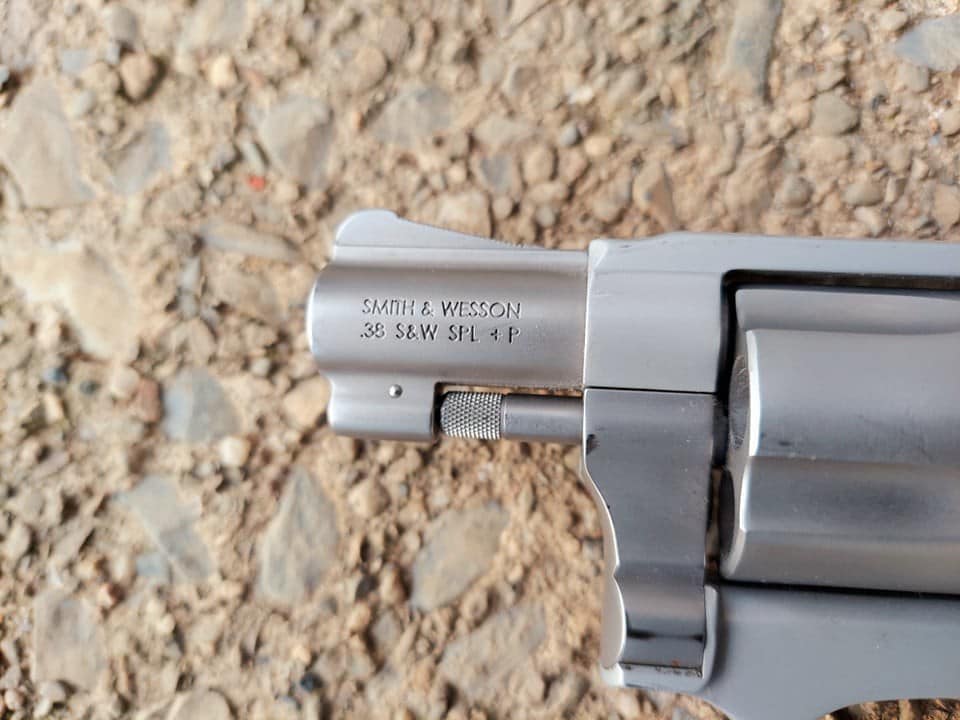
The Sights
The sights on the little wheel gun are rudimentary but adequate for the purpose. The positive is they won't get knocked out of alignment, and they're sufficient to get the job done. The downside, however, is they're not adjustable. The rear sight is simply a groove cut out of the top of the receiver, with the front sight being a ramp machined into the end of the barrel.
Can you make hits at 25 yards with this pistol? Depending on your skills, yes, you'll be taking your time if you do so. This is a five or ten-yard gun for all practical purposes. And that's precisely for what it's intended.
Consider the 3–3–3 rule: most gunfights take place at three yards, expend roughly three rounds of ammunition, and are over in about three seconds. Yes, there are exceptions. Sometimes, the exceptions are profound, and we all know scads of instances where gun battles raged at absurd distances and expended untold amounts of ammo. I like to be prepared for any possible exceptions to the rule that I can be. But this little revolver will allow you to cover most of the bases. Without me sounding like a complete buffoon for stating the obvious, carrying a 5-shot revolver will bring some compromises with it. You have to ask yourself if you believe the advantages of carrying a light, small handgun outweigh the disadvantages. And sometimes, we just say, “Screw it, I'm just going to do it.”
The Trigger
It's heavy, seriously heavy. The trigger being heavy is not entirely a terrible thing. You don't have to worry about accidentally pulling the trigger when you're carrying in deep cover. Hell, it's hard to pull the trigger intentionally (I'm only partially joking)! I don't have a trigger scale to weigh the pull, but all the information I've seen indicates a pull of around 12 pounds, which I find believable. From this aspect, the little revolver is safer to carry than an auto with a light trigger pull.
One seriously positive thing about the trigger is that the pull is very smooth, and it gets smoother with use. I use some Snap Caps and have done a good deal of dry firing, which smooths up the trigger in addition to helping me develop a good trigger squeeze. You practice and get used to the trigger, and you'll have no problems.
I find the matte gray finish of the S&W revolvers to be quite attractive; it's one of my favorite finishes on a handgun. Simply put, it just looks cool!

At the Range With the Smith and Wesson 642 Airweight
Firing the 642 is “snappy.” It lets you know that it's going off. If you stuff +P hollow points into it, things will get even more interesting. The grips, as mentioned, do an excellent job of soaking up that snappy recoil, but this little gun is so light that there's no way around it; there's no mistaking that you're touching off some rounds. It's meant to be carried a lot instead of a “fun” range gun.
Is this a good beginner's gun? I'm not sure I'd recommend it for someone just starting. Many people make the same mistake because they pick up a handgun at a gunshop, and it feels nice in hand. It's light. It looks pretty, and it might even be “cute.” The money changes hands, the gun follows them home, and they take it to the range. They touch off the first round and are surprised that it's unpleasant to shoot. Even worse, they missed the entire damn target!
What's wrong with this piece of crap? It won't shoot! It feels like the devil himself smacked my hand when I shot it! Well, nothing's wrong with the gun. You chose the wrong one based on your limited or non-existent skill level.
How to Run the Smith and Wesson 642 Airweight
To effectively run this handgun, you need a little bit of strength to pull that trigger, a stiff wrist to keep it on target during rapid-fire, and some tolerance for the snappy recoil. In addition, focus is required to keep this gun putting rounds on target with the lightweight and extremely short barrel. As a result, even experienced shooters will need some practice with this little guy.
My Glock 19X is a pleasure to shoot; I hold onto it, and it's as if the pistol fires itself and holes magically appear in the target. It's the opposite with the Smith and Wesson 642 Airweight; once you begin pulling the trigger, you fight every aspect of the gun to make those holes appear in the target.

You can expect fist-sized groups at five yards in rapid-fire if you do your part. Keeping rounds on the silhouette rapid-fire at ten yards is not out of the question. Just remember to be realistic.
Finally, we all know that revolvers are historically very reliable. There's no feed ramp for rounds to hang up on. No stove pipe stoppages, no double feeds. No magazine to fumble or cause a stoppage. Just reliable feeding. Understand, revolves can and occasionally do malfunction. It's just that they seldom do. The timing of the cylinder can get out of synch, or recoil can cause projectiles to back out of the cases, locking up the cylinder. But as we said, these things seldom happen.
Revolvers are far less ammo sensitive, too, as opposed to autoloaders because there's no action to cycle. As a result, they work with heavy loads, light loads, in-between loads; you name it, they run through a revolver as a fat kid runs through a candy store.
My 642–2 has one item that I don't care for very much: a key lock on the left side of the receiver. On paper, it sounds great that the owner can lock his pistol, making it safe from unauthorized use. But, realistically, if I want to do such a thing, I'll just lock the entire gun away.
I've never had an issue with this integral lock. But according to internet forums, these locks routinely lock the revolvers up, disabling them from shooting. Of course, everyone who makes these claims has never had it happen to him; it's always a friend's brother-in-law's cousin who claims the story. I don't know anyone who's ever had his revolver lock up due to the integral lock. Maybe it happens, but…?
Wrapping It Up
The Smith and Wesson 642 Airweight provides a lightweight, easily concealable handgun in a serious caliber. It allows us to be armed under circumstances where we might otherwise not be armed. A little 5-shooter on us beats our favorite blaster that we left at home or under the seat in our car. All of this in an attractive-looking package that is super reliable. These days, I most often carry an auto with more capacity, but the little Airweight still fills an important niche, which I greatly appreciate.
Many of my friends and contacts agree, as the revolver still has a strong, dedicated following these days. Some love it strictly for its classic, nostalgic value, while others enjoy its practical aspects. I guess I have a foot in both of those groups. At the time of this writing, I believe they are selling for around $430, depending on where you find one. Come on; you know you need one. You'll get one sooner or later, so why not make it sooner?
Read the original article in its entirety at medium.com.


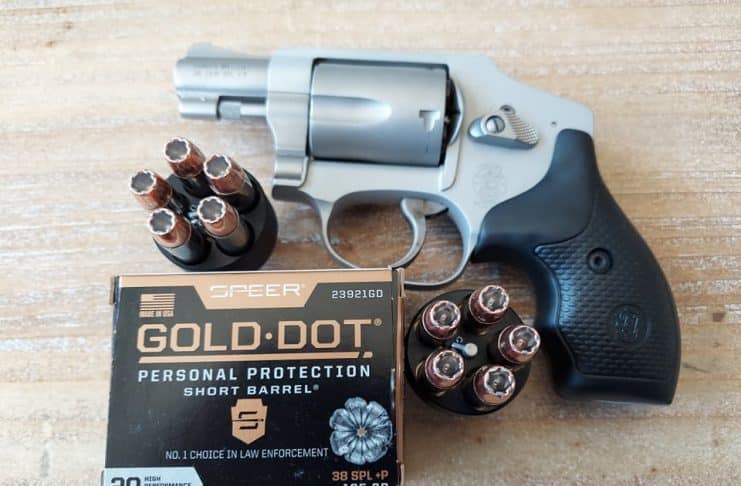
At least my old light weight J frame is a six shooter.